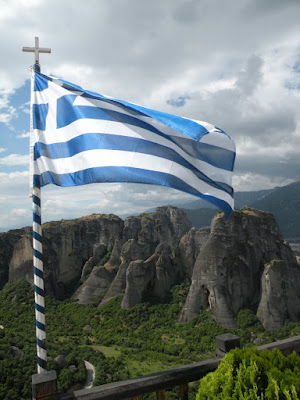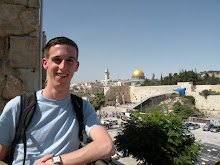
The beach at the resort on the Aegean Sea where we stayed for two nights! Mt. Olympus (home of the Greek gods) is in the background. We got a free day on the beach, which was so nice to have in the midst of these days filled with history (even though it is absolutely fascinating). I used the day to do nothing and just enjoy the Greek beauty. :-) The first day we got there, it was stormy, so we were thankful that it was nice the following day (our free day). The weather at that area around Mt. Olympus is pretty quick-changing - made me feel like I was really at the home of the gods!

The foundations of a bath house at the base of Mt. Olympus in the city of Dion. You can see how the floor would have been on top of all these "mini-poles," allowing the steam to come up through the floor and create a steam room. The bath houses were centers of debate and discussion among society's elite.

We visited Meteora, a place which literally means "hung in the air." Starting in 1340, hermit monks began to build Greek Orthodox monasteries on top of these huge sandstone rock pillars. Here I'm standing overlooking the Varlaam monastery.

Me and our crazy Greek tour guide, Voula! I feel like I'm in the movie "My Big Fat Greek Wedding" 24/7. She's great. Oh, and the beautiful rock pillars with monasteries on top are in the background!

The Greek flag from the top of one of the monasteries. Notice the cross at the top. The blue represents the sea and the white, the cloudless sky. The nine stripes represents the nine syllables of the phrase "Freedom or Death," in Greek.

We visited an icon factory that makes iconography for Greek Orthodox churches and even the Vatican! Here a man is hand-painting one of the icons. It was incredible to see their process first hand. They even make their own canvases! They were also selling small icons, but they were very expensive. I saw one triptych (a three-fold icon piece) that was being sold for 14,000 euros - that's about $17,500! Wow!
One of the things I got to thinking about a lot in Turkey and now in Greece is the concept of sacred space. In the Greek Orthodox Church, their worship space is clearly set apart: it isn't used for other "activities" like we use our sanctuaries. These spaces are clearly defined as places for meeting God. I think in the West we miss the power of a sacred space, originating even from the Jewish Holy of Holies. A specific, physical place that is dedicated to sanctified worship and service. The Greek Orthodox view decoration as an earthly reflection of heavenly beauty. As a result, their sacred spaces are often heavily adorned, gilded and mystical. Is there a place for that? Is that idolizing a place? Confining God?
The Orthodox view iconography as a reflection and celebration of the Incarnation: because God has become flesh, we can represent him through icons, and that is an honor and privilege. So is there a place for iconography? Is all iconography idolatry? Do visual images help in our worship?
These questions swirl in my head as I explore the roots of early Christianity and forms of worship foreign to my own.
Peace.

No comments:
Post a Comment